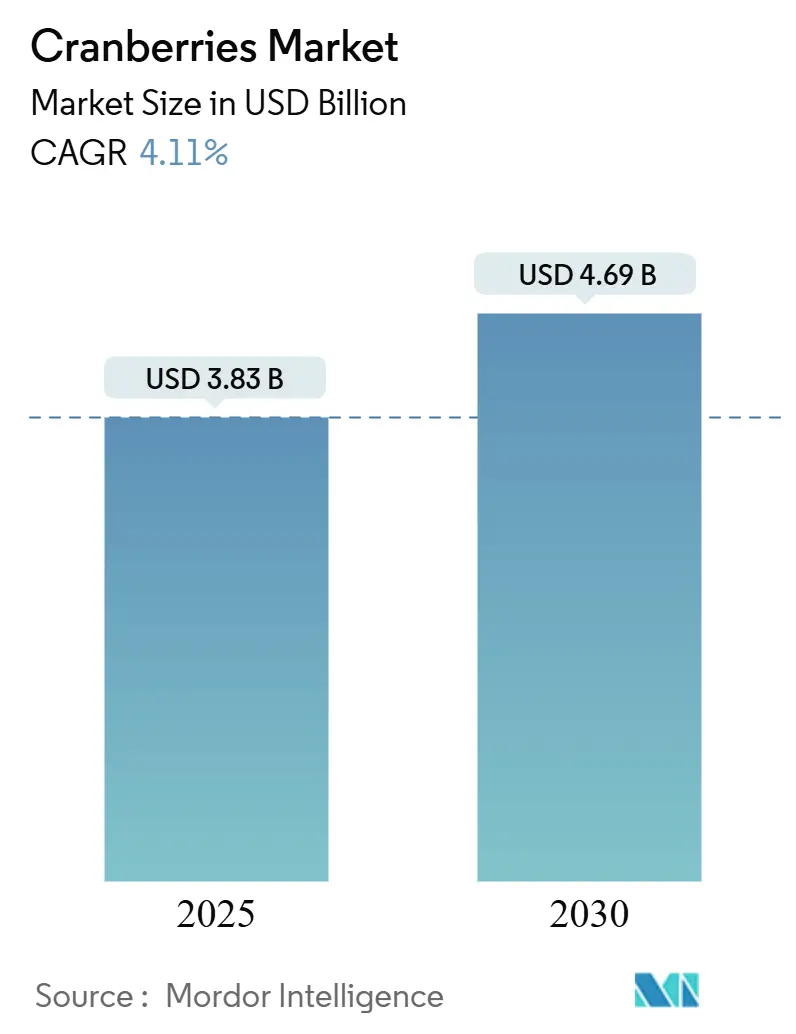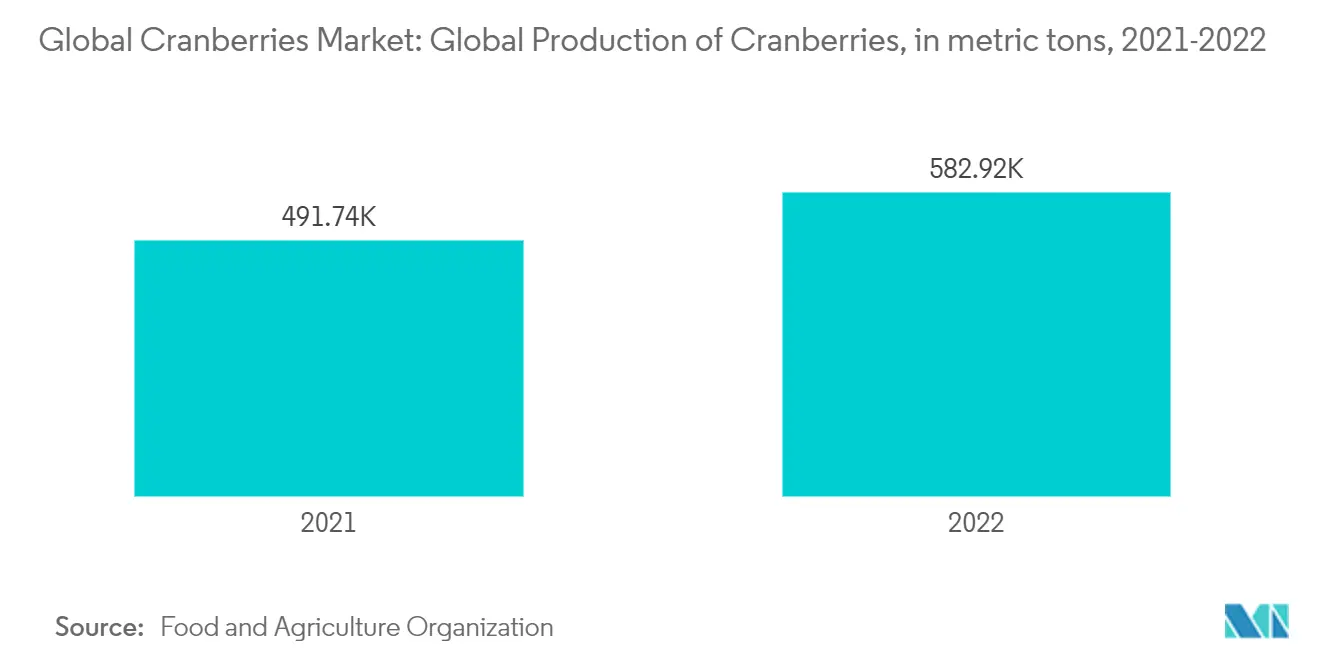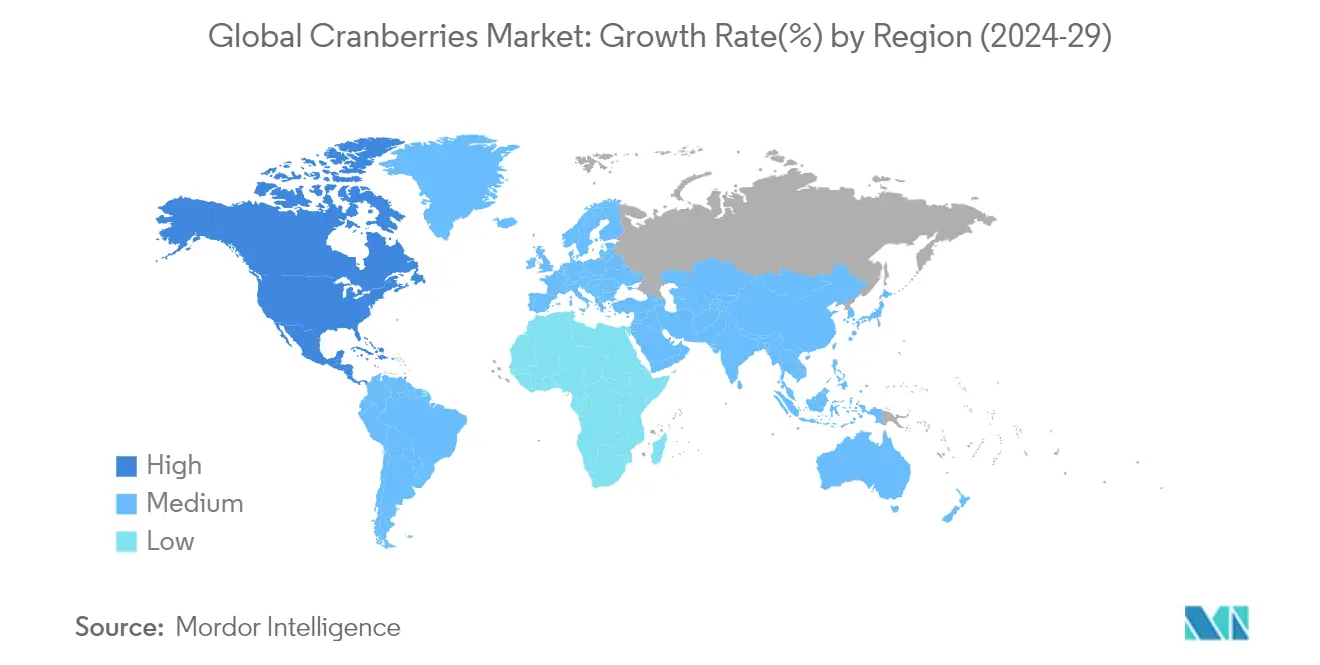Cranberries Market Analysis
The Cranberries Market size is estimated at USD 3.83 billion in 2025, and is expected to reach USD 4.69 billion by 2030, at a CAGR of 4.11% during the forecast period (2025-2030).
- Due to their sour taste when consumed raw, cranberries are predominantly enjoyed as juice. This perennial crop thrives in man-made wetlands or bogs across five US states. FAOSTAT reported that global cranberry production reached 582,923.64 metric tons in 2022, an 18.5% increase from the 491,737.31 metric tons produced the previous year. Moreover, the rise of functional foods and beverages focusing on health benefits beyond essential nutrition drives cranberry use in products such as juices, supplements, and snack bars.
- The major importing nations are the United States, the Netherlands, the United Kingdom, Germany, Canada, China, and Poland. Americans consume nearly 400 million pounds of cranberries annually. The increasing popularity of cranberries in international markets, particularly in Europe and Asia, has driven global demand and contributed to the growth of the cranberry industry.
- Also, the antioxidant and anti-inflammatory traits contribute to better cardiovascular health, enhanced metabolism, and boosted immune function. Rich in phytochemicals, cranberries combat oxidative cell damage, potentially warding off diseases. Consumption of cranberries prevents urinary tract infections (UTIs) due to their unique compounds called proanthocyanidins (PACs). Given these health advantages, the cranberry market is poised for positive growth during the forecast period.
Cranberries Market Trends
Increasing Demand from the Processing Industry
- As demand for processed cranberry products surges, processing industries increasingly turn to cranberries, particularly in North America. Processed cranberry offerings encompass juices, jams, jellies, sauces, dried cranberries, powders, and extracts. While cranberries, native to North America, are enjoyed in diverse forms, fresh, ground, mashed, or even baked with cornmeal, dried cranberries are uniquely paired with dried meats. For instance, Ocean Spray has over 700 farmers who produce 65% of cranberry production. In 2023, the company invested USD 75 million and expanded its Wisconsin Rapids facility, doubling its size to 440,000 square feet. The upgrade incorporates advanced energy-efficient technologies, aligning with the growing global demand for sweetened dried cranberries.
- Cranberries are increasingly sought after in their fresh form and as poultices, medicinal teas, and dyes. In the United States, a mere 5% of the harvested cranberries are sold fresh, with a dominant 95% being processed, predominantly into juice and juice blends. Driven by heightened demand from the processing industry, North America's cranberry production surged from 476,822 metric tons in 2021 to 577,519 metric tons, marking a notable 21.11% increase as reported by FAOSTAT. This significant boost in production can be attributed to market-operating companies' rapid expansion of processing facilities.
North America Dominates the Market
- North America dominates cranberry production, accounting for 98.5% of the global share. Cranberries thrive predominantly in the northern regions of North America, with significant cultivation taking place in states such as Massachusetts, Wisconsin, New Jersey, Oregon, and Washington. North America boasts an annual harvest of approximately 200 billion cranberries, translating to sales surpassing USD 1.50 billion. FAOSTAT data indicates that in 2022, the area dedicated to cranberry cultivation reached 23,898 hectares, marking a 2% increase from the previous year.
- The United States is the world's foremost cranberry producer, with Canada trailing behind. In 2022, US farmers cultivated cranberries across 15 thousand hectares, yielding a production volume of 365,500 metric tons. As per FAOSTAT, the United States accounted for 63% of North America's total cranberry output. While cranberry production has seen a steady uptick, consumption patterns have shifted from seasonal to year-round, largely fueled by the growing use of cranberries in processing.
- Also, the United States leads in cranberry exports, sending shipments to nations such as India, the Philippines, and Peru. USDA reports highlight that in 2022, US cranberry exports were valued at USD 293.6 million, with Wisconsin emerging as the top-producing state and the European Union recognized as the primary export market. Ocean Spray, the United States's largest processing entity, also sources significant volumes from Eastern and Western Canada. The company boasts a diverse product range, manufacturing fresh cranberries, cranberry concentrate, sweetened dried cranberries (SDCs), cranberry-based juices, and cranberry sauce. This broad product portfolio underscores the heightened demand driving the North American cranberry market.
Cranberries Market News
- February 2024: As part of a protracted World Trade Organization dispute, India eliminated customs duties on cranberry imports through an agreement with the United States.
- September 2023: Ocean Spray expanded its Wisconsin Rapids facility by doubling its size to 440,000 square feet and making it the largest cranberry processing plant in the world. This USD 75 million investment, which included advanced energy and environmental technologies, has significantly increased the production of sweetened dried cranberries.
Cranberries Industry Segmentation
Cranberry plants thrive in natural or artificially created wetlands and are cultivated commercially. Renowned for a wealth of vitamins and beneficial plant compounds, cranberries are pivotal in combating urinary tract infections (UTIs). These berries are predominantly used in processing industries, leading to a diverse range of products, including juices, sauces, dried cranberries, powders, and extracts. The latter is predominantly utilized in supplements.
The cranberry market is segmented by geography (North America, Europe, Asia-Pacific, South America, and Africa). The report includes production analysis (volume), consumption analysis (value and volume), export analysis (value and volume), import analysis (value and volume), and price trend analysis.
The report offers market size and forecasts in terms of value (USD) and volume (metric tons).
| Geography | North America | United States | Production Analysis | |
| Consumption Analysis and Market Value | ||||
| Import Market Analysis (Volume and Value) | ||||
| Export Market Analysis (Volume and Value) | ||||
| Wholesale Price Trend Analysis | ||||
| Canada | Production Analysis | |||
| Consumption Analysis and Market Value | ||||
| Import Market Analysis (Volume and Value) | ||||
| Export Market Analysis (Volume and Value) | ||||
| Wholesale Price Trend Analysis | ||||
| Mexico | Production Analysis | |||
| Consumption Analysis and Market Value | ||||
| Import Market Analysis (Volume and Value) | ||||
| Export Market Analysis (Volume and Value) | ||||
| Wholesale Price Trend Analysis | ||||
| Europe | Germany | Production Analysis | ||
| Consumption Analysis and Market Value | ||||
| Import Market Analysis (Volume and Value) | ||||
| Export Market Analysis (Volume and Value) | ||||
| Wholesale Price Trend Analysis | ||||
| United Kingdom | Production Analysis | |||
| Consumption Analysis and Market Value | ||||
| Import Market Analysis (Volume and Value) | ||||
| Export Market Analysis (Volume and Value) | ||||
| Wholesale Price Trend Analysis | ||||
| Spain | Production Analysis | |||
| Consumption Analysis and Market Value | ||||
| Import Market Analysis (Volume and Value) | ||||
| Export Market Analysis (Volume and Value) | ||||
| Wholesale Price Trend Analysis | ||||
| Netherlands | Production Analysis | |||
| Consumption Analysis and Market Value | ||||
| Import Market Analysis (Volume and Value) | ||||
| Export Market Analysis (Volume and Value) | ||||
| Wholesale Price Trend Analysis | ||||
| Asia-Pacific | China | Production Analysis | ||
| Consumption Analysis and Market Value | ||||
| Import Market Analysis (Volume and Value) | ||||
| Export Market Analysis (Volume and Value) | ||||
| Wholesale Price Trend Analysis | ||||
| Azerbaijan | Production Analysis | |||
| Consumption Analysis and Market Value | ||||
| Import Market Analysis (Volume and Value) | ||||
| Export Market Analysis (Volume and Value) | ||||
| Wholesale Price Trend Analysis | ||||
| Japan | Production Analysis | |||
| Consumption Analysis and Market Value | ||||
| Import Market Analysis (Volume and Value) | ||||
| Export Market Analysis (Volume and Value) | ||||
| Wholesale Price Trend Analysis | ||||
| South America | Chile | Production Analysis | ||
| Consumption Analysis and Market Value | ||||
| Import Market Analysis (Volume and Value) | ||||
| Export Market Analysis (Volume and Value) | ||||
| Wholesale Price Trend Analysis | ||||
| Peru | Production Analysis | |||
| Consumption Analysis and Market Value | ||||
| Import Market Analysis (Volume and Value) | ||||
| Export Market Analysis (Volume and Value) | ||||
| Wholesale Price Trend Analysis | ||||
| Brazil | Production Analysis | |||
| Consumption Analysis and Market Value | ||||
| Import Market Analysis (Volume and Value) | ||||
| Export Market Analysis (Volume and Value) | ||||
| Wholesale Price Trend Analysis | ||||
| Africa | South Africa | Production Analysis | ||
| Consumption Analysis and Market Value | ||||
| Import Market Analysis (Volume and Value) | ||||
| Export Market Analysis (Volume and Value) | ||||
| Wholesale Price Trend Analysis | ||||
Cranberries Market Research FAQs
How big is the Cranberries Market?
The Cranberries Market size is expected to reach USD 3.83 billion in 2025 and grow at a CAGR of 4.11% to reach USD 4.69 billion by 2030.
What is the current Cranberries Market size?
In 2025, the Cranberries Market size is expected to reach USD 3.83 billion.
Which is the fastest growing region in Cranberries Market?
North America is estimated to grow at the highest CAGR over the forecast period (2025-2030).
Which region has the biggest share in Cranberries Market?
In 2025, the North America accounts for the largest market share in Cranberries Market.
What years does this Cranberries Market cover, and what was the market size in 2024?
In 2024, the Cranberries Market size was estimated at USD 3.67 billion. The report covers the Cranberries Market historical market size for years: 2019, 2020, 2021, 2022, 2023 and 2024. The report also forecasts the Cranberries Market size for years: 2025, 2026, 2027, 2028, 2029 and 2030.
Our Best Selling Reports
Cranberry Industry Report
Cranberries Industry Report





